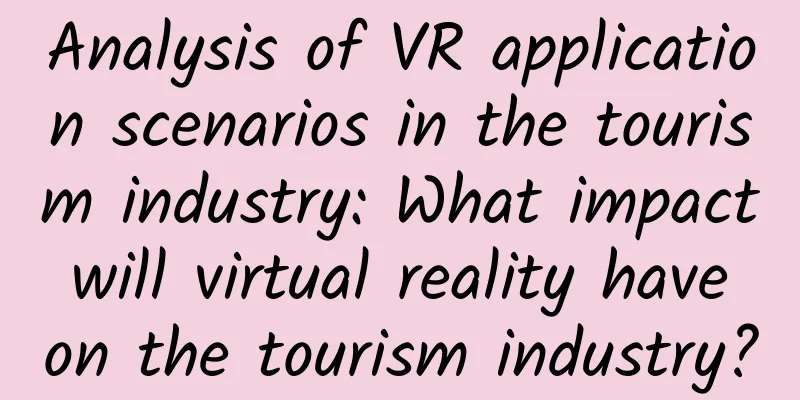Analysis of VR application scenarios in the tourism industry: What impact will virtual reality have on the tourism industry?

|
With the rapid development of virtual reality technology, virtual reality is entering a period of rapid development, and the investment in hardware products and content products is increasing significantly. According to data from Deutsche Bank in early 2016, compared with two years ago, the amount of funds and developers currently used to solve VR technical problems is 10 times that of the original, and 100 times that of five years ago. Since Facebook acquired Oculus, venture capital in the VR field has increased by 3 times, and VR companies announce investment almost every day. In 2015, there were about 300 VR companies in China, and in 2016, it is expected that there will be thousands of AR and VR companies. In the virtual reality industry chain, upstream hardware equipment is the part with the fastest development, hottest investment and highest returns. Currently, there are several desktop VR platforms and a large number of mobile VR helmets, and competition has begun among the giants. The VR market seems to be experiencing a fierce competition environment similar to that of the smartphone market. There are already several VR helmet manufacturers with mature technology and good "presence" in the market, such as Facebook's Oculus, HTC Vive, Samsung's Gear VR, Auravisor, PS VR, etc. One of the important reasons why virtual reality is entering a period of rapid development is the rapid development cycle and product release. Another important manifestation is that since 2016, there have been too many salons, forums, and entrepreneurship and innovation conferences on VR entrepreneurship in China. The development and progress of display, chip, sensor and other technologies and the expansion of user base have prepared for the improvement of VR content ecology and practical application. New VR application cases are emerging every day and are widely used in games, news event live broadcast, social experience, VR business, health care, fitness, social advertising and sponsorship content, entertainment and movies, communications, training and teaching simulation, tourism and other fields. From a technical perspective, VR uses technical means and the principle of human binocular parallax to give users a completely immersive experience (some have interactive functions). After putting on the helmet, it feels the same as the real life environment. The ultimate goal of VR is to give users the feeling of "dreaming with open eyes."
At the 2015 F8 Developer Conference, Zuckerberg showed a VR travel video for tourists who wanted to go to a small town in Italy. Instead of looking at static pictures or videos and browsing reviews of some hotels and restaurants, people can virtually "go to the field" to explore, such as strolling in a market or city square, and feel the real experience. Today, beaches, jungles, waterfalls, pyramids and other wonders of the world can be "experienced" through VR systems. In the future, when VR technology reaches a fully mature state and VR content is extremely rich, users will be able to browse beautiful scenery around the world without leaving home, or preview the destination city, hotel, and scenic spot in advance before going out for a trip. Compared with simple flat photos and videos, users can obtain richer destination information through VR. For example, users can know the environment around the hotel they are about to stay in, the three-dimensional orientation of the local city, and other detailed information. For tourists, VR can dispel their worries and uneasiness about unknown factors in the destination before traveling. At present, some companies are trying to apply VR in the tourism field. The application of VR technology in the tourism industry is mainly focused on VR immersive interactive experience (mainly used in theme parks) and advertising and marketing to inspire potential tourists to start traveling (mainly destination marketing). For example, in sports viewing, the immersive feeling of VR can bring the feeling of watching the game live, but this application is still in the small-scale trial stage.
The combination of VR and roller coasters in theme parks brings some completely different experiences. In the past, when people sat on a fast-moving roller coaster, they were accompanied by the thrilling screams of passengers; but with VR immersive content, users may feel like they are flying through the clouds, flying in the stars, or exploring a planet outside the sky. In January 2016, Thorpe Park and Alton Towers in the UK announced the launch of virtual reality roller coaster experience and virtual reality ghost train experience. In March, Samsung announced that it would join hands with Six Flags, the world's largest theme park, to build a virtual reality roller coaster for consumers using Samsung Gear VR devices, allowing people to have a breakthrough multi-dimensional virtual roller coaster experience. When experiencing a virtual reality roller coaster, people still sit on a real roller coaster, but the riders wear Gear VR devices, which will play pre-customized VR videos to provide users with a different visual experience. Of the 9 roller coasters to be launched this time, 6 are built-in alien invasion themes, and people will fight aliens on the roller coaster; the other 3 are mainly about Superman fighting villains. These videos are made based on real-life data from the gyroscope, accelerometer and various sensors on the helmet device. Another way to combine VR with theme parks is to use VR to create a virtual reality theme park. The VOID in the United States has already created a prototype product. The core of The Void theme park experience is to redefine the concept of walking. Players wear customized gloves and helmets with a 180-degree field of view and explore in a 60*60 meter room (called a stage). Since the props on the stage are carefully designed, players can really feel the "steel pipes", "door handles", "walls" and "stones" that feel the same as in reality during the "exploration". On this "stage", theme adventure entertainment activities with different plots can be staged, such as anti-terrorism gun battles, desert adventures, and battles with aliens. To some extent, this is very similar to VR interactive games, with a good sense of immersion and excitement. At present, in addition to the Huaqiang Fantawild Theme Park in China, there are also manufacturers in Germany, Melbourne, Italy and other places who are trying to use VR technology to create a new generation of theme parks. With the development of VR technology, this more exciting, shocking, novel and cool travel experience will capture the hearts of many tourists, because it allows tourists to instantly immerse themselves in an unparalleled virtual space. In terms of construction and operating costs, VR virtual theme parks have great advantages. The construction of traditional physical theme parks is very expensive. For developers and operators, they will face financial pressure and bear risks such as design, construction, manpower and financial resources. The risk of building a virtual theme park is much smaller, and the park can regularly change the entertainment theme and launch more and more scenes to achieve "various styles".
Before traveling, people need to select hotels and learn about the scenery of the destination in advance. Before arriving, they can only understand the actual situation through two-dimensional pictures and videos. However, this display method cannot fully meet the user's needs for hotel information when booking a hotel. For example, whether a hotel room faces the sun, how much space it has, and the surrounding situation of the hotel, etc. Two-dimensional space pictures and videos cannot tell users these. VR can fill the information gap between high user needs and existing product display methods by displaying 3D multi-dimensional space panoramic videos. The application of VR technology in the hotel industry has already been a precedent. In October 2010, Shangri-La Hotels launched a VR project, showing 360-degree panoramic videos of 94 hotels and resorts under the Shangri-La Hotel Group. In December 2015, the travel website Zannadu launched the country's first travel VR mobile application, which allows users to have a more realistic experience of travel destinations. In March 2016, online travel service provider eLong released a hotel VR experience video, introducing VR technology in user experience, providing users with an immersive service when choosing a hotel. Currently, eLong has set up a VR laboratory X Lab to be responsible for VR production, which has become a rare new move after eLong was acquired. At almost the same time, GCH Hotel Group, the largest hotel management company in Europe, produced VR works for 120 international hotel brands including Accor, InterContinental, Wyndham, etc. These hotels are located in Germany, the Netherlands, Belgium, Austria, the United Kingdom, Spain, Cyprus, etc. These VR works can be viewed through Google virtual reality helmets Google Cardboard or Oculus Rift. In terms of scenic spots and destination marketing, in the past two years, domestic and foreign tourism bureaus and scenic spot operators have also introduced VR projects. Foreign countries have tried this relatively early. For example, the Mexican Tourism Board has begun using the Aurasma App, which allows potential customers and visitors to experience the travel they offer through virtual experience books and postcards; Qantas has built brochures into virtual reality helmets to provide passengers with a 360-degree immersive and novel experience service; the South African Tourism Board has condensed thrilling projects into a 5-minute virtual reality video for tourists to experience. In addition, the Tourism Development Board and travel agencies have also launched an activity to produce 360-degree high-definition and two-channel sound South African-style promotional videos, which will be delivered to bars in London and Manchester, allowing consumers to wear virtual reality helmets in the bars to stimulate their desire to consume; Azamara Cruises has developed Azamara 3D using virtual reality to allow passengers to experience cruise life "firsthand", such as driving a cruise ship through the Costa Rican rainforest or touring the Panama Canal. In January this year, the 36th Spanish International Tourism Fair (FITUR) was held at the Madrid International Convention Center. The Chinese booth launched 360-degree panoramic virtual glasses, allowing foreign friends to experience China's tourist attractions.
Now if a user has a smartphone or a tablet, he is just one step away from watching sports in a completely different way. There are a wide variety of mobile VR glasses and helmets available on the market, including Baofeng Magic Mirrors that cost hundreds of yuan, mobile phone boxes that cost tens of yuan, and products such as Samsung Gear VR, HTC VIVE, and Oculus that cost thousands or tens of thousands of yuan. The price reduction of terminal equipment has promoted the growth of mobile VR users. With more and more 360-degree panoramic cameras on the market, VR panoramic content is becoming more and more abundant. Now users can watch various VR panoramic videos on applications such as Youku, Baofeng Video, LeTV, or Panorama Guest, and adjust the camera angle by tilting or rotating the phone. In this way, the mobile phone screen actually becomes the eyes for browsing the scenery or watching the game, which brings hope for people to use virtual reality to watch games and performances on the field. For event operators or performance organizers, the application of VR technology has opened up new business opportunities for them. Organizers will find ways to make full use of such opportunities. The number of spectators is no longer limited to the on-site audience, and virtual tickets may also be sold for profit, which will also play a plus role in attracting sponsorship. The above is the actual application of VR that people are trying in the tourism industry - "using the sense of presence to deceive users' vision, hearing and touch." Many authoritative people believe that virtual reality content will become the next industry-changing technology, changing people's current lifestyles like mobile Internet. Such comments have attracted the attention of many investors and entrepreneurs.
There are many different opinions on this question, but fortunately, we can find some clues from the development of technology in recent years. There are some short-term and medium-term challenges that may affect the popularity of VR. Similar to the smartphone market between 2007 and 2010, it will take time to form a large and vibrant VR developer community. For smartphones, app downloads did not really take off until 2011-2012, so the VR ecosystem will also need the same time. In addition, we have also noticed that in modern times, judging from the trajectory of the popularization and development of television, computers, smart phones, the Internet and mobile Internet, the time for the popularization and development of various technologies has become shorter and shorter, especially the explosive development of mobile Internet (the development foundation behind it is the popularization of the network infrastructure 3G/4G and the launch of smart phones such as Apple). The popularization of VR also relies on hardware (including portable personal VR content production equipment and head-mounted display equipment) and a new generation of wireless communication technology (5G high-speed Internet access), plus an industry "trigger point" (which may be a killer application that profoundly changes people's lives) to accelerate the industry into a new stage. Some of the core challenges currently facing VR are mainly reflected in the following points: 1. Mobile VR is not yet "fully present". Mobile VR does not meet the standards in terms of frame rate and latency, and cannot allow users to truly immerse themselves in the VR experience. In addition, there are problems such as limited battery life, lack of motion controllers, and limited storage space, but these problems are expected to be solved in the next few years. 2. Desktop VR is expensive and still has some minor technical issues. The biggest challenge facing desktop VR should be the price issue. For consumers, the first experience of VR may require an investment of $1,500-2,000, not including content purchases. 3. The biggest challenge for VR is content. Content is the guarantee to attract users to interact with it every day. At present, although there are many "cool" applications on display, for non-game players, there is no must-have.
Well-made VR videos can now amaze most first-time users, and the visual effects are very realistic. However, in addition to vision, other senses of touch are still not well presented, such as smell and touch. Users cannot really immerse themselves in it, and there is a sense of distance in vision. One user said, "I feel like I have entered a box and come to an open ground. I want to run but I am trapped in the same place." This is the feeling that virtual reality videos bring to people. VR content cannot replace people traveling to their destinations for vacation, but it can have great potential in tourism marketing, advertising, and creating new entertainment projects to inspire people to travel and make better travel decisions. From: Zuoyu Capital |
<<: Mom University: How to unclog the fallopian tubes
Recommend
Ten dietary prescriptions to regulate female qi and blood deficiency
Qi and blood deficiency is a disease that many wo...
Could a weak positive result be an ectopic pregnancy?
Nowadays, if many women suspect that they are pre...
Clinical symptoms of wind infection during confinement
Confinement is a very important link and should n...
Can I use air conditioning during confinement?
Confinement after childbirth is a tradition in my...
What are the benefits of eating a chicken drumstick every day? Is it good for cardiovascular health and can it help you live longer?
Eat a delicious chicken leg! Who can resist the t...
What is the best way to treat polycystic ovary?
The ovaries are important organs in the female bo...
Can I swim during my period?
Women become weaker than usual during menstruatio...
Can I eat cherries during my menstrual period?
Menstruation is a physiological phenomenon unique...
What are the recovery methods for cesarean section?
Nowadays, many women choose cesarean section when...
What are the causes of cervical intraepithelial neoplasia?
A very strange phenomenon is that we usually pay ...
What should I do if there is a lump in the milk that is blocked?
If there is a lump and pain in the milk duct due ...
What medicine is used for fungal vaginitis
If you want to treat candidal vaginitis, it is ac...
What is leucorrhea and why is it milky white and odorless?
Leucorrhea is something that women encounter in t...
Can breast cysts heal on their own? Can I choose traditional Chinese medicine for treatment?
Generally speaking, breast cysts cannot heal on t...
Female urethral pain is actually like this
In daily life, many female friends experience ure...









